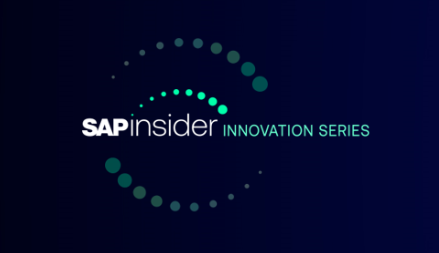SAP Manufacturing
Filter By
Browse By
- SAP Analytics and AI
- SAP Application Development and Integration
- All SAP Application Development and Integration
- SAP ABAP
- SAP ABAP Development Tools
- SAP ABAP Test Cockpit
- SAP API Management
- SAP BAPI
- SAP Basis
- SAP BRF
- SAP Business Application Studio
- SAP CMS
- SAP Design Studio
- SAP Development Tools
- SAP DevOps
- SAP EAI
- SAP EDI
- SAP Extension Suite
- SAP Fiori
- SAP Fiori Elements
- SAP Integration Suite
- SAP Low Code Application Development
- SAP Low Code Automation
- SAP Netweaver
- SAP Release Management
- SAP UI5
- SAP Web Application Server
- SAP Web IDE
- SAP Business Process Management
- SAP Center of Excellence
- SAP CIO
- SAP Customer Experience
- SAP Data and Data Management
- All SAP Data and Data Management
- SAP BW
- SAP BW/4HANA
- SAP Crystal Reports
- SAP Data Archiving
- SAP Data Center
- SAP Data Governance
- SAP Data Integration
- SAP Data Migration
- SAP Data Quality
- SAP Data Services
- SAP Data Strategy
- SAP Data Visualization
- SAP Data Warehouse Cloud
- SAP DMS
- SAP Document Control
- SAP EIM
- SAP ETL
- SAP ETL Tools
- SAP HANA
- SAP HANA Administration
- SAP HANA Deployment Infrastructure
- SAP HANA Studio
- SAP Master Data
- SAP Master Data Governance
- SAP MDM
- SAP Enterprise Architect
- SAP Enterprise Asset Management
- SAP ERP
- SAP Finance
- All SAP Finance
- SAP Accounting
- SAP AR AP
- SAP Asset Accounting
- SAP Billing Systems
- SAP BPC
- SAP BRIM
- SAP Cash Management
- SAP Central Finance
- SAP Controlling
- SAP COPA
- SAP Cost Center Accounting
- SAP Currency Risk
- SAP e-invoicing
- SAP FICO
- SAP Finance Automation
- SAP Advanced Financial Closing
- SAP Financial Consolidation
- SAP Financial Planning
- SAP FX Risk
- SAP General Ledger
- SAP Global Tax Management
- SAP Hyperion
- SAP Order to Cash
- SAP Payment Processing
- SAP Profitability Analysis
- SAP Rebate Management
- SAP S/4HANA Finance
- SAP SWIFT Compliance
- SAP Treasury Management
- SAP Universal Journal
- SAP Governance Risk and Compliance
- SAP Human Capital Management
- SAP Intelligent Technologies
- SAP Platform and Technology
- All SAP Platform and Technology
- SAP Business Technology Platform
- SAP Cloud
- SAP Cloud Connector
- SAP Cloud Integration Platform
- SAP Cloud Migration
- SAP Cloud Platform
- SAP Cloud Providers
- SAP Cloud Strategy
- SAP Digital Signature
- SAP Container Platform
- SAP HANA Enterprise Cloud
- SAP Digital Asset Management
- SAP Smart Forms
- SAP HEC
- SAP Digital Integration Hub
- SAP Hyperscalers
- SAP Infrastructure
- SAP Messaging
- SAP Quality and Testing
- SAP Security
- SAP Spend Management
- SAP Supply Chain Management
- All SAP Supply Chain Management
- SAP APO
- SAP Asset Management
- SAP Business Network
- SAP Digital Manufacturing Cloud
- SAP Digital Twin
- SAP EWM
- SAP IBP
- SAP Inventory Management
- SAP Label Printing
- SAP Logistics
- SAP Manufacturing
- SAP Manufacturing Automation
- SAP MES
- SAP MII
- SAP MM
- SAP MRO
- SAP MRP
- SAP Order Management
- SAP Plant Maintenance
- SAP PLM
- SAP Production Planning
- SAP S&OP
- SAP SD
- SAP SPM
- SAP Supply Chain Planning
- SAP Track and Trace
- SAP Transportation Management
- SAP System Administration
Manufacturing Defined
Manufacturing refers to the creation of finished goods with the help of equipment, labor, machines, tools, parts, and raw materials. It includes variable factors like supplies, equipment, overhead, parts, and skilled workers. Production planning and scheduling contain comprehensive planning features and integrated scheduling to create efficiencies and lower costs. Modern manufacturing solutions include on-premise deployment, collaboration enterprise-wide, seamless digital capabilities, and real-time analytics for problem-solving and robust decision-making.
SAP Manufacturing
Key Capabilities of SAP S/4HANA Manufacturing for planning and scheduling include:
- Comprehensive end-to-end planning: Planning production resources beyond material requirements planning (MRP) functionality, considering capacity and material availability constraints in the planning model, and integrating manufacturing master data.
- Integrated scheduling: Streamline scheduling through global production environments, use industry scheduling for block, campaign, shelf-life and model mix planning, and perform detailed scheduling.
Manufacturing Defined
Manufacturing refers to the creation of finished goods with the help of equipment, labor, machines, tools, parts, and raw materials. It includes variable factors like supplies, equipment, overhead, parts, and skilled workers. Production planning and scheduling contain comprehensive planning features and integrated scheduling to create efficiencies and lower costs. Modern manufacturing solutions include on-premise deployment, collaboration enterprise-wide, seamless digital capabilities, and real-time analytics for problem-solving and robust decision-making.
SAP Manufacturing
Key Capabilities of SAP S/4HANA Manufacturing for planning and scheduling include:
- Comprehensive end-to-end planning: Planning production resources beyond material requirements planning (MRP) functionality, considering capacity and material availability constraints in the planning model, and integrating manufacturing master data.
- Integrated scheduling: Streamline scheduling through global production environments, use industry scheduling for block, campaign, shelf-life and model mix planning, and perform detailed scheduling.
Key Capabilities of SAP S/4HANA Manufacturing for production engineering and operations include:
- Streamlined engineering: Digital collaboration with master data, design handovers, process planning, and change management. Simplify build package creation, management, and delivery for global environments.
- Enhanced operations management: Analyze change impact and change implementation. System-optimized monitoring of shop floor operations with issue detection, root cause analysis, and decision support.
The importance of manufacturing is that it leads to research and development, innovation, productivity, exports, and jobs. It helps to raise living standards and generates more economic activity than any other business sector.
3 benefits are:
- Simplify functionality: Digital enterprise collaboration to simplify product planning, change management, and operations. Decrease days in inventory by integrating scheduling and execution for a full view of product data.
- Optimize adaptability: Minimize production disruptions in shop floor execution. Reduce cycle time by adapting production schedules to plant conditions.
- Enhance planning capabilities: Streamline build package creation, planning, and shop floor operations. Reduce revenue loss from stock outs by improving flexibility into production planning scenarios.
Vendor partners to modernize your manufacturing and increase efficiency include: Forcam, SAP, and Movilitas.
Key Considerations for SAPinsiders are:
- Expert Panel Discussion: Boost Manufacturing Agility and Flexibility with SAP HANA. Listen to leaders engage about the state of manufacturing agility and flexibility by using SAP HANA.
- Belmo Increases Warehouse Productivity and Order Fulfillment by 30%. Read the case study on how the use of technology, like machine learning, can have significant benefits.
- Industry 4.0: The Journey to the Future of Productivity. Read about the importance of digital technologies, but also understand automation and collaboration are the path to success.
498 results
-

SAP for Cell and Gene Therapy: 4 Solutions to Consider
Reading time: 3 mins
Cell and gene therapy (CGT) presents unique challenges in manufacturing and compliance due to its personalized nature, but SAP solutions can streamline processes, enhance supply chain visibility, and ensure regulatory compliance, ultimately improving efficiency and coordination within CGT companies.
-

How SAP Uses Emerging Technologies to Help Its Customers Realize Their Dreams
Reading time: 11 mins
Q: You’ve had a lot of roles within SAP. Could you tell us a little bit about your path to your current role within SAP? A: I have always been curious and wanted to understand how companies run. And what better way to do that than to join the world’s largest enterprise software provider and…
-

Digitize and Streamline Your New Product Introduction (NPI) Processes for More Agile Manufacturing
Reading time: 2 mins
Manufacturing is undergoing massive change due to omnichannel shopping, heightened customer demand, and more transparency and speed needed in the manufacturing process. Smaller, more agile start-ups are disrupting the territory that has long been held by large organizations. Learn how to digitize and streamline your SAP system data to gain the agility needed in today's…
-
-

Industry 4.0 – The Journey to the Future of Productivity
Reading time: 5 mins
Manufacturing companies are often overwhelmed by the breadth of Industry 4.0 technologies and are not quite sure where to begin their digital transformations. Learn how to assess product bottlenecks and inefficiencies and how to build incrementally on end-to-end processes such as design to operate. Because unique customer demands heavily affect product design and manufacturing, manufacturers…
-

SAP AI – Powering the Digital Supply Chains
Reading time: 4 mins
AI is not new to supply chain management. Many companies are already using AI to resolve supply chain challenges like sales and operations planning and other supply chain data pools to manage demand fluctuations, supply constraints, production scheduling, and dynamic distribution. Data reveals that AI-enabled supply-chain management has allowed early adopters to improve logistics costs…
-

Transforming Manufacturing from Shop Floor Chaos to a Smart Factory
Reading time: 3 mins
A Manufacturing Execution System (MES) integrates with the Industrial Internet of Things (IIoT) to create a real-time, intelligent factory environment that enhances planning, execution, and dynamic scheduling, ultimately transforming disconnected operations into a cohesive, self-adaptive system.
-

 Premium
Premium
How to Configure and Test Flexible Planning to Improve Performance and Increase Profits
Reading time: 22 mins
A good conceptual understanding of the Flexible Planning component of SAP Sales and Operations Planning (SAP SOP) helps reduce the number of cyclic iterations in Information Structure configurations and test its impact on the planning type before choosing the final design. Learn the necessary steps to configure Flexible Planning in your SAP system, including configuring...…
-
-

 Premium
Premium
Improve Your Cost Center Planning with Driver-Based Planning
Reading time: 16 mins
See how to plan cost center activities automatically with driver-based planning. Learn how it works in both manufacturing and service departments. Key Concept Driver-based planning is a best practice in the manufacturing industry, in which companies often use the sales plan as a starting point for the production plan and the production plan to determine...…
-

- SAP Cost Center Accounting
 Premium
Premium
Enhance Cost Center Variance Reporting for Manufacturing Organizations
Reading time: 14 mins
Discover how having detailed activity types map to each work center level can provide you with detailed variance analysis at the cost centers. Key Concept Activity types specify the manufacturing activities produced in plant-related cost centers. Multiplying activity types used in the production process through the assigned production cost centers creates more transparency and provides...…
-

- SAP S/4HANA Finance
 Premium
Premium
Plan Your SAP S/4HANA Finance Implementation with an Understanding of Multicurrency Architecture
Reading time: 21 mins
Learn about the multicurrency architecture in SAP S/4HANA Finance and discover how to set up the right solution design aligned to Generally Accepted Accounting Principles (GAAP), external reporting, and internal management reporting needs. Key Concept In both the classic General Ledger and the SAP General Ledger, you can define three parallel currencies in FI, two...…
Become a Member
Unlimited access to thousands of resources for SAP-specific expertise that can only be found here.
Become a Partner
Access exclusive SAP insights, expert marketing strategies, and high-value services including research reports, webinars, and buyers' guides, all designed to boost your campaign ROI by up to 50% within the SAP ecosystem.
Upcoming Events
Related Vendors
Your request has been successfully sent


